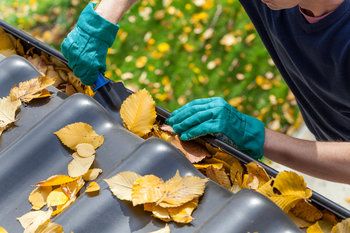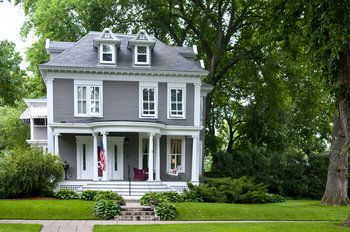 When you're buying a home, you are acutely aware of the numbers -- the down payment, mortgage rate, closing costs, fees and so much more. But one of the things you might not consider is what comes after the sale is done, and that's the money you should set aside for home repairs and maintenance.
When you're buying a home, you are acutely aware of the numbers -- the down payment, mortgage rate, closing costs, fees and so much more. But one of the things you might not consider is what comes after the sale is done, and that's the money you should set aside for home repairs and maintenance.
A good rule of thumb is to budget between one and three percent of your home's purchase price each year to cover typical homeowner maintenance. If you're considering renovation, or if your home is an older one, it's best to err on the side of caution and set aside three percent each year. For a $100,000 home, that's about $3,000.
Though that number is great to cover regular maintenance and the occasional surprise -- like a burst pipe or broken window -- bigger problems could lead to a much higher expense. While it's a good idea to have a nest egg of savings to take care of those unexpected problems, you might be able to avoid those issues altogether by sticking to a homeowner's maintenance checklist.
Our timeline doesn't just look at the monthly tasks; we've also taken a look at what you need to do on a yearly basis, and then even further out, in five or ten years or later. If you plan to stay in your home for a long time, this checklist should help keep you safe and comfortable. If you're thinking about moving, consider it a kind of home renovation timeline that helps you keep the home in great shape for sale down the road.
Here's what your home needs from you.
Monthly Home Maintenance
Performing a few simple monthly maintenance tasks on your home can prevent costly repairs down the road. The good news is that most of these chores are DIY-friendly, should only require common household tools, and cost very little to perform. Let's take a look at what you should be doing each and every month:
- Check HVAC system filters. Some air filters are reusable, while others are disposable and must be replaced. Clean or replace filters when they get dirty, which might be anywhere from 30 days to a few months.
- Look for leaks around toilets and sinks. Any sign of water where it shouldn't be is reason to investigate further. Even a tiny leak could cost hundreds of dollars each year, as illustrated by this chart from the City of New York.
- Inspect grout and caulking. Touch up any voids or cracks in tubs and showers. This keeps them looking nice while helping to avoid seeping water damage.
- Check kitchen vent/range hood filter. Clean or replace if needed. Consider looking at the filter more often if you have an avid chef in the household.
- Test smoke and carbon-monoxide detectors. In addition to a monthly test, Consumer Reports explains why you should change batteries every six months. Make a habit of changing the batteries when you change your clocks during Daylight Savings Time.
- Trip your GFCI outlets. These can be located anywhere in your home, but are most commonly found close to water sources (bathroom, kitchen, laundry room). Plug a light into the outlet, then click the "test" button to see if the light goes out, then click "reset" and see if the light goes back on. If so, you're good; if not, it's time to replace the outlet.
- Stroll around outside. You're probably outside your home on a regular basis, but how often do you really look it over? Walk around the house and any outbuildings, looking for problems with the foundation, vents, gutters, downspouts and drainpipes.
Some of your monthly checklist is likely to change with the seasons. Here's what to do during each:
Winter Household Maintenance Tasks
Unless you're a fan of cold weather, your natural inclination might be to hunker down during the winter and wait for spring's arrival. However, before going into hibernation mode, there are a few winter home maintenance chores you should attend to:
- Watch for ice dams. An ice dam is a ridge of ice that builds up at the bottom of a roof, trapping snow and melting water behind it. This can allow water to infiltrate the roof. Get in touch with a contractor to fix the problem so it never happens again. Here's a good overview of ice dams from the National Weather Service.
- Check for drafts. Cold air slipping in around doors and windows can cause higher heating bills. Use this simple trick: light a stick of incense and slowly move it around the seams of doors and windows. When the smoke blows around instead of rising in a straight line, you've got a draft. Many gaps can be eliminated by applying a little caulk.
- Test your sump pump. If you have a basement sump pump, make sure the switch is on and pour a little water in the crock to ensure it starts. Many basement leaks occur during upcoming spring thaws, so check it now to be safe. Check the backup battery, too. Review more information on sump pumps from the North Dakota State University Extension Office.
- Close foundation vents. Crawl space ventilation is good for your home during the spring, summer, and fall. However, during the winter months, closing the vents can help lower your heating costs.
- Cover outdoor air conditioning units. Snow and ice can damage outdoor air conditioning units if they aren't protected. Covers are available at most home improvement stores, but even a secured canvas tarp will do. If don't have central air conditioning and instead use window air conditioners, store them inside to protect them or wrap them in place until spring.
Spring House Upkeep
Winter can be tough on your home -- even if you live in an area that receives little or no snowfall. Here's the springtime homeowner's maintenance checklist to ensure your home is ready when spring flowers begin to bloom:
- HVAC checkup. It's a good idea to have your system tuned up before air conditioning season arrives. Always use a trained professional for this. Many companies offer discounts to those who sign maintenance agreements for spring and fall tune-ups.
- Roof inspection. Winter snow and ice can damage shingles which could lead to leaks. You can inspect your roof with binoculars, but don't go up there. According to the Consumer Product Safety Commission, about 500,000 people are injured in ladder-related accidents each year. Roof repairs are best left to a qualified contractor.
- Check gutters. Ice buildup during the winter months can cause gutters to loosen and sag. Gutters that don't drain properly may create drainage issues -- left for a season or two, an unstable gutter can spill enough water to damage the foundation.
- Inspect sidewalks and driveway. Cracks and buckles caused by freezing temperatures should be repaired before they become a major issue.
- Check seals around doors and windows. Check for drafts again. Cracked caulking should be touched up to prevent the loss of cooled air all summer.
- Check storm-window drains. Older homes often have triple-track storm windows and screens, and these usually have small drains to prevent rain puddling, which can rot wooden window sills. Make sure any rain that does get trapped can flow out.
Summer Home Care
Vacations, golf outings or lounging by the pool may be on your schedule this summer, but save a little time for your home. Relax with the knowledge that your house is ready for summer by taking care of these chores before hitting the links:
- Trim around outdoor HVAC units. Grass and weeds growing around the units can affect their efficiency and could even cause expensive damage.
- Inspect your decks. If the wood is beginning to show its age, summer can be a good time to apply a coat of stain or sealant. Take the time to tap down any protruding nails and sand any rough areas to ensure safety throughout the seasons.
- Check siding. Warm weather is ideal for pressure washing vinyl or fiber cement siding. Pay close attention to each piece of siding as you clean it, looking for cracks, soft spots and any other signs of trouble.
- Inspect foundation and crawlspace. Look for cracks that may need repair. Check the crawlspace right after a heavy rain to make sure there's no water getting in there.
- Test lawn irrigation system. If you have an underground lawn irrigation system, leaks in the pipes or connections can cause your water bills to skyrocket. The Environmental Protection Agency offers excellent tips for maintaining your irrigation system.
Fall House Maintenance
Before you get too caught up carving pumpkins or watching football, reserve a few weekend hours to take care of these autumn home maintenance tasks:
- HVAC system inspection. Have a qualified HVAC mechanic inspect your system to ensure it's ready to heat your home all winter.
- Turn off outside hose bibs. If you don't have frost-free exterior faucets, shut off their water supply and drain the lines to prevent freezing. While you're at it, roll up hoses and get the outside of your home tidy for winter.
- Inspect the fireplace. Always have a professional inspect wood stove and wood burning fireplace chimneys prior to starting the first fire of the season. The Chimney Safety Institute of America reports an average of 22,300 chimney fires each year; a good fireplace and chimney cleaning can help keep your home from becoming a statistic.
- Clean gutters and check roof. Remove all debris that can trap snow and water during the winter. If you live in a one-story home, this can be a DIY-project for you and a partner.
- Check your weather stripping. Weather stripping around doors and windows can become worn or compressed over time, limiting its effectiveness against cold drafts. Try the draft test suggested in the Winter section and see if its time for replacement.
- Check exterior grade. Fill in any depressions near the foundation that can trap water or snow. These water issues could eventually lead to damp basements, settling or foundation damage.
Yearly Home Upkeep
Just like you, your house and its many components get a year older every 12 months. Here are a few annual maintenance tasks that can help your home age gracefully:
- Clean clothes dryer exhaust. Lint buildup in the dryer vent will affect the dryer's efficiency and may create a fire hazard. In fact, about 15,500 house fires are caused by clothes dryers each year. The National Park Service offers some interesting ideas on what to do with all the lint.
- Lubricate garage door springs. Whether you have an opener or not, greasing your garage door springs can make it much easier to operate.
- Drain hot water heater. Sediment that collects in the bottom of the heater can affect its longevity. If you're not sure how to drain the water heater, this tutorial from the City of Cambridge, MA has the answers you seek.
- Look for signs of termites. A swarm of termites can lead to huge expenses. This termite primer from the EPA can help you spot them.
- Clean septic tank. If your sewage collects in a tank, it should be inspected annually and emptied as needed. The average household needs a septic tank cleaning every two or three years.
- Check your fire extinguisher. At least once per year, check the gauge to see if it is still holding the proper pressure, that its hose in not dry rotted, and the date it was certified or manufactured. Most non-rechargeable fire extinguishers need to be replaced every 10 years.
- Exercise fixture supply valves and inspect lines. These include supply valves and lines for toilets, faucets, clothes washer and dishwashing machines, ice makers and more. Valves that aren't opened and closed occasionally may seize over time, and not being able to turn them off promptly in case of a leak may create an even bigger headache.
- Clean your bathroom exhaust fan. These can become clogged with lint, dust, hairspray and more, hurting efficiency. This may be as simple as pulling the fan cover off the ceiling and using a vacuum, and some fans can be easily removed to be fully cleaned.
- Clean refrigerator coils. Haven't pulled out your refrigerator in a while? You'll be amazed at how much dirt and dust will collect in the air passages under your fridge. Use a brush and vacuum and/or compressed air canister to get things cleaned up again, which can improve efficiency and save energy, too. If you have pets that shed, consider doing this twice per year.
Home Maintenance Every 2 - 5 Years
Several large maintenance issues pop up as your home approaches its fifth birthday. Fortunately, most of the issues are relatively inexpensive to handle and many are DIY-friendly.
- Clean heat ducts. Accumulated dust and dirt may eventually restrict airflow and might even pose a health hazard. Call in a professional to clean the ducts, as well as repair or upgrade them if necessary. The Department of Energy offers a wealth of information on duct work.
- Seal grout. Avoid stains and discoloration by adding a fresh coat of sealant to your bath and kitchen tile grout. This will also help ensure no water infiltration.
- Get a termite inspection. You should look for evidence of termite damage to your home every year, but a professional inspection every few years can find hidden problems before they turn into major costs. Some companies offer free inspections.
- Replace caulking around windows and doors. All caulking eventually gets too old to do its job effectively. Installing new material can help keep your home energy efficient.
Household Chores for Every 5 - 10 Years
As your home gets older, components often begin to wear out. Longevity is normally determined by frequency of use, but here are a few items that might need attention as your house reaches the end of its first decade:
- Paint the exterior. If your home has wood siding, don't wait until flaking starts to think about painting. If you're not well-versed in painting, it's probably best to hire a pro.
- Install a new dishwasher. Consumer Reports says a dishwasher will last about 10 years. When looking for a new one, try out an Energy Star model to save both water and money.
- Replace the kitchen sink. Steel sinks begin to show their age after five years of use and often must be replaced before reaching 10 years of service. This can be a DIY project if you have the right tools and the ability to work in tight places.
- Replace the microwave. Microwaves often wear out after about nine years of use. Small counter-top models might have a shorter lifespan. The good news is that microwaves seem to get more affordable every year.
Long-Term Home Maintenance: Every 10 - 15 Years
Many of your home's components need replacement every 15 years. Here are a few items that may need attention:
- Replace the hot water heater. Gas and electric hot water heaters normally last 10 years or so. Replacing an electric unit can be a DIY project for handy homeowners, but gas models should always be installed by a professional. Use the Energy Star Product Finder to help you find your next unit.
- Replace the garage door opener. Most garage door openers last 10 to 15 years depending on frequency of use. A new unit can often be installed by an experienced homeowner, but in many cases it might be best to hire a contractor.
- Install a new refrigerator and range. Most refrigerators and ranges last in the neighborhood of 13 to 15 years. Installing electric models is normally just a matter of plugging them in, but gas ranges should always be installed by a qualified contractor.
- Replace your smoke detectors and carbon monoxide detectors. Even if your detectors seem to be working properly, err on the side of caution and replace them at the ten-year mark. It's a small investment that could save your property or even your life.
Home Improvement Tasks Beyond 15 Years
At the 15 year mark there are several maintenance tasks that might be required that could put a hefty dent in your budget -- but that's why you've been saving money toward the cause each year! These components may need replacement to keep your house safe and energy efficient:
- Check the roofing material. The life expectancy of a roof varies based on the type of materials. Many asphalt shingle roofs last from 20 to 30 years, but some higher quality materials can protect your home much longer. Check out this Consumer Reports buying guide for handy tips.
- Replace exterior decks. Your local weather and how often sealant is applied can determine how long your home's wooden deck remains safe and structurally sound. The average lifespan of a wooden deck is considered to be about 20 years. Some might look into home equity loans for this kind of home improvement.
- Replace kitchen and bathroom faucets. It may be time to replace your kitchen and bath faucets when they're about 15 years old. A handy homeowner should be able to handle the project if they have the right tools.
- Install new HVAC units. The life expectancy of your home's HVAC system components is largely determined by how they're maintained. However, even units that have been properly serviced begin wearing out when they're 15 to 20 years old -- in some cases even sooner. New units should always be installed by a qualified professional. The Department of Energy can help you research the purchase of a new system.
Keeping Your Home Safe and Secure for a Lifetime
If you're planning to live in your home for a very long time, this homeowner's maintenance checklist will help ensure your home is safe and secure. If you're looking at a home renovation timeline, keeping up with these tasks in addition to making big renovations can help ensure a better resale value in the future. Either way, proper maintenance can give your home a fighting chance to stand strong for generations.
This article was previously updated by Shannon Lee.




This article is a must-read by every homeowner on how to maintain their home especially the roofs.
Hello. Thanks for the helpful article. I think that it is very important to conduct these maintenances. This will avoid many problems that may arise with the engineering systems or the main constructions of the house (especially the roof). It is also very important to conduct periodic inspection and repair of HVAC systems. For these purposes, it is best to sign a contract with a contracting company. I did not do periodic inspections and repairs of the main engineering systems and building constructions of my house. As a result, problems arose (the water heater failed in winter). Therefore, I had to pay a lot of money to quickly solve this problem. The tips described in the article need to be observed!